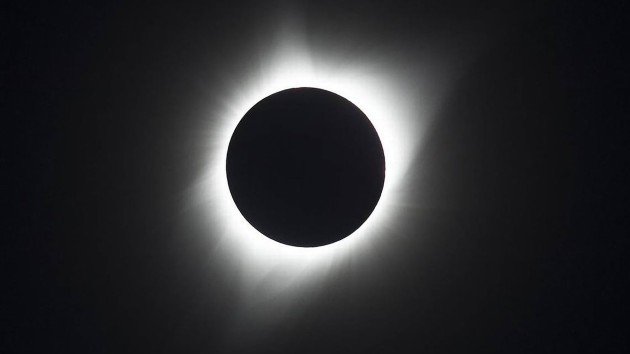-
 play_arrow
play_arrow
WMEX WMEX Boston
-
 play_arrow
play_arrow
Courage To Hope-Episode 82-Michael Courage To Hope-Episode 82-Michael
Getty Images – STOCK
(NEW YORK) — When millions of people look to the skies on April 8 to witness the total solar eclipse, scientists will be studying how the phenomenon will affect plant and animal activity on Earth.
The eclipse may last just mere minutes for those in the path of totality, but the effect it has on the natural world will be profound, researchers told ABC News.
Plants and animals will begin to react in the lead-up to totality as the light begins to dim, said Angela Speck, professor of physics and astronomy at the University of Texas at San Antonio.
“Once it gets to about 75%, 80% eclipsed, there’s enough sunlight missing that animals will start to react,” she said.
About 20 minutes from totality, birds will start to flock. Some will quiet down. Farm animals, like cows and chickens, will walk back to the barn because they think it’s now nighttime, previous research as shown.
Then, once totality hits, the behavior will start to change again, Speck said.
Previous research has shown that bees stop buzzing during totality and returned to their hives. Then, when the sunlight re-appeared, the bees seemed disoriented, according to a paper published in the Annals of the Entomological Society of America after the 2017 eclipse.
“This transition out of it is probably something that they’re not expecting, and I think that could be a period of confusion,” Brent Pease, an assistant professor at South Illinois University’s School of Forestry and Horticulture, told ABC News. “It’s hard to exactly say what these individuals or animals are experiencing.”
A study conducted by the University of Missouri-Columbia during the 2017 eclipse found that some plants closed up during totality and others followed the sun as the moon moved over it.
Based on reports dating all the way back to the 1500s, researchers can expect breeding birds to quiet down during the eclipse, Pease said. This is likely a defense mechanism, to avoid detection from predators during dark periods, he added.
The driver behind most of these effects is a big change in light stimuli, Pease said.
Birds think it’s “bedtime,” Speck said.
Crepuscular nocturnal insects, such as crickets, will begin to vocalize as the light dissipates, Pease said. “Crickets respond very quickly to changes in light sources,” he said.
There is also evidence that spiders will begin to engage in web maintenance — typically a nighttime behavior for them to catch potential meals overnight, Pease explained.
One interesting case occurred with the Galapagos tortoise, a study published in 2020 found. The typically slow and lethargic species were observed to get the urge to mate during the 2017 eclipse, the researchers observed.
While various studies have already been done, researchers will continue to study the impact of a total solar eclipse — especially given how long it will be until the next solar eclipse occurs.
At Southern Illinois University, scientists will be studying insects and birds in the regions based on soundscapes made during the eclipse, Pease said.
The project, part of the NASA-funded Eclipse Soundscapes project, relies on citizen science reporting for the breadth of its data, with more than 200 participants in 64 counties in the Midwest, Pease said.
“We’re increasing scientific engagement around the really exciting event, and we’re really kind of increasing scientific accessibility,” Pease said.
It will be another 350 years before a total solar eclipse passes through southern Illinois, Pease said, emphasizing the importance of the research that’s taking place on April 8.
What is not clear is what happens to nocturnal animals when the eclipse occurs, Speck said. There are several bat caves in the San Antonio region that will be examined, Speck said.
For this eclipse, there will be several accredited zoos on the path of totality, allowing researchers to observe animal behavior more closely, Speck noted.
Those on the path of totality can also expect the temperature to drop significantly, Speck said. Depending on the humidity, temperatures could drop up to 10 degrees in the minutes the sun is completely covered in regions that are experiencing dry conditions.
“There’s a lot of experiments on just understanding how the atmosphere is changing as we switch off the sun,” Speck said.
Amphibians often react quickly to changes in light that cause changes in temperature — even “micro” changes in temperature, Pease said.
Researchers expect the vast majority of the impacts to be temporarily, lasting just minutes.
“We’ve got hundreds of years of information about what might be happening with the wildlife communities,” Pease said. “But the exciting thing here is all of those hundreds of years of information are just qualitative. Now we’re at a point where we have the conservation technology and the computing power to quantitatively assess very precisely exactly how things are changing and how these changes might dissipate with distance from the path of totality.”
Copyright © 2024, ABC Audio. All rights reserved.
Similar posts
CONTACTS
- https://wmexboston.com
- 781-834-WMEX(9639)
- studio@wmexboston.com
- 130 Enterprise Dr, Marshfield, MA 02171
ABOUT
WMEX Boston can be heard at 1510 AM, and 101.1 FM. Playing the greatest hits from 50s, 60s, 70s, 80s, and more!
MENU
SPONSORS
Copyright 2024 WMEX Boston - Design by Pro Radio Solutions





